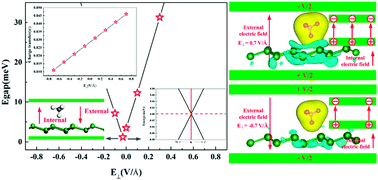Tuning the electronic properties of germanene by molecular adsorption and under an external electric field
Abstract
The effects of both molecular adsorption and external electric field on the electronic properties of germanene are investigated through first-principles calculations in this work. The molecular adsorption-induced intrinsic electric field by small molecules (SMs) breaks the symmetry of two sublattices in germanene, leading to a band gap opening from zero to 3.2 meV, even up to 81.0 meV. Under an external electric field, a wide ranging linearly tunable band gap (0–69.39 meV for the germanene/methane system and 37.66–134.17 meV for the germanene/ammonia system) can be realized, which is merely determined by the strength of the composited electric field independent of its direction. More importantly, the band gap of germanene/SMs can be closed and reopened under a critical electric field. On the other hand, the mechanism of charge transfer between germanene and SMs under an external electric field is revealed by an equivalent capacitor model to explain the tunable charge transfer. The composited field-induced charge transfer could be promoted when an external electric field and a molecular adsorption-induced internal electric field have the same direction. Otherwise, the charge transfer will be inhibited. Particularly, the tunable electronic properties of germanene are sensitive to the concentration of molecular adsorption under an electric field, representing multiple-effects that would significantly enhance the performance of germanene for electronic devices in the future.



 Please wait while we load your content...
Please wait while we load your content...